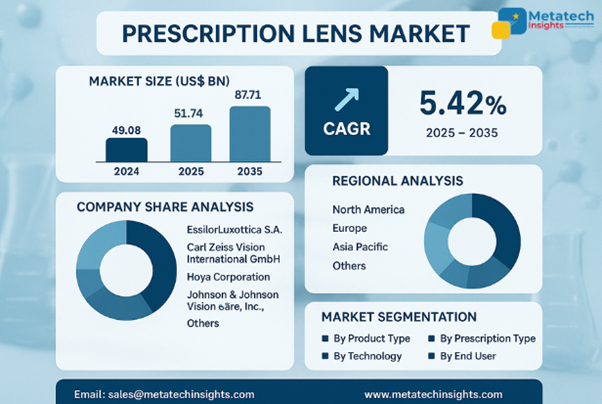Global Prescription Lens Market to Hit USD 87.71 Bn by 2035 | CAGR 5.42%
27 Aug 2025 | Report ID: MI3352 | Industry: Healthcare | Pages: 220 | Forecast Year: 2025-2035

Read more about this report- Global Prescription Lens Market to Hit USD 87.71 Bn by 2035 | CAGR 5.42%
- The Prescription Lens Market is valued at USD 49.08 billion in 2024.
- The Prescription Lens Market will achieve USD 87.71 billion by 2035 through a projected 5.42% CAGR from 2025 to 2035.
- The Prescription Lens Market is experiencing tremendous growth due to rising awareness regarding eye care procedures, an augmented incidence of eye-related conditions, and the changing use of corrective eyewear among all age groups. Other factors that are driving the growth of the market are technologies, lifestyle changes, and interest in the prevention of eye care in the world. Sophisticated lens design, lightened structures, multi-function composed lenses, and technologies are increasing consumer use and popularity.
- Market segmentation can further be grouped under product type, which comprises single vision lenses, bifocal lenses, and progressive/multifocal lenses. Single vision lenses are most popular in the market because they are extensively used in the correction of myopia and hyperopia, whereas bifocal and progressive lens glasses are gaining popularity among the grey population that is interested in a smooth transition among multiple distances through vision correction.
- According to prescription type, the lenses are broken down into myopia, hyperopia, astigmatism, and presbyopia. Myopia correction is the most prevalent lens type in the world and therefore the largest category, with the presbyopia lens type growing fast, considering the large aging global population in mature markets.
- The technology segment includes the conventional lenses, photochromatic lenses, anti-reflective coatings, and lenses that filter blue light. Lenses that use technological innovations, such as smart lenses or lenses that protect against digital eye strain, are also emerging as consumers demand vision correction with lifestyle and extra benefits to enhance their experience.
- The market is further divided by end users such as ophthalmology clinics, optometry centers, hospitals, and consumers. The largest base could be reported in retail consumers, and this has been attributed to the daily corrective needs and the rising fashion trends in eyewear.
- Factors such as a spur in disposable income, spread of eye-care awareness, diffusion of distribution channels, and product innovations contribute to the market growth. Some of the new opportunities in differentiation and consumer engagement are features of lightweight materials, coatings that are made scratch-resistant, and clean environments in manufacturing.
- In terms of geography, the market is classified into North America, Europe, Asia Pacific, Latin America, and the Middle East & Africa. North America dominates the market due to the awareness levels, well-developed retail network, and early penetration of the new type of lenses. Asia Pacific, in the meantime, experiences the fastest growth rates, on the back of growing urbanization, the widespread occurrence of visual disorders, and the government policies targeted to promote eye health.
- The key companies influencing the prescription lens market include EssilorLuxottica S.A., Carl Zeiss Vision International GmbH, Hoya Corporation, Johnson & Johnson Vision Care, Inc., and other market players. These companies are laying emphasis on strategic product launching, innovative lens technologies, sustainable operations, and multichannel methods of distribution in order to intensify their competitive presence and meet emerging consumer demands.
Maximize your value and knowledge with our 5 Reports-in-1 Bundle - over 40% off!
Our analysts are ready to help you immediately.
